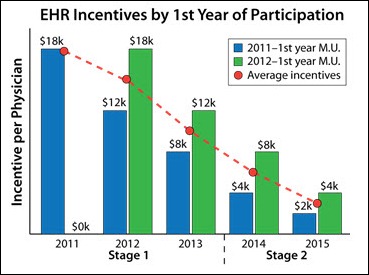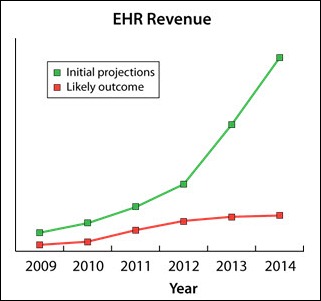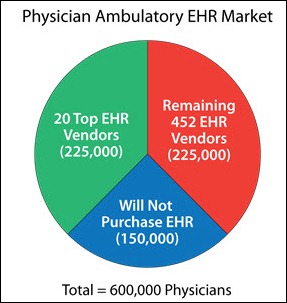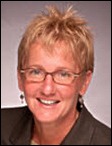Giving a patient medications in the ER, having them pop positive on a test, and then withholding further medications because…
Readers Write 1/18/12
Submit your article of up to 500 words in length, subject to editing for clarity and brevity (please note: I run only original articles that have not appeared on any Web site or in any publication and I can’t use anything that looks like a commercial pitch). I’ll use a phony name for you unless you tell me otherwise. Thanks for sharing!
The EHR Bubble Will Pop—To the Victor Go the Spoils
By Evan Steele
There is no question that the EHR incentives have created a frenzy of EHR purchasing and that the trend will intensify in 2012 because this is the last year to qualify for the full $44,000. As I look at what’s happening in the market, it becomes apparent that at some point in the not-too-distant future, the EHR bubble will pop and many vendors will face financial challenges that will lead to their demise.
Despite the surge in EHR purchases in 2011 and 2012, it is important to recognize that there will be some unintended consequences of the rush to meet the government’s deadlines and requirements. Many physicians will be unhappy with their newly acquired EHR because, in their haste, they made a poor product choice. Others will face a rude awakening as they are forced to use their EHR in ways they never have before, and discover that it does not support their workflows. In the rush to market, there will also be some products that, while certified, are of inferior quality—possibly developed offshore.
Vendors will be backlogged and unable to manage the surge in new purchases in a timely manner due to insufficient staffing levels. Many will come to market short of the necessary educational resources to help physicians navigate the complexities of Meaningful Use, and physicians will find themselves victims of inadequate, rushed EHR implementations by green, wet-behind-the-ears trainers. Other vendors will be so overwhelmed that they will fail to keep to their promised implementation schedules, preventing their new clients from meeting the government’s timetable entirely.
In the years following the initial boom, many physicians will become disillusioned with the EHR Incentives Program. There will be too many requirements that will seem either burdensome or irrelevant to their practice—or both. As the increasingly stringent Stage 2 demands are weighed against the drastically decreasing dollar value of the incentives, physicians will either abandon the program or trade the EHR they originally purchased for one that supports not only the government’s needs, but also the workflow needs of their practices.
To see what will happen to many of the EHR companies, it is important to understand how they are financed. In order to raise money, companies had to show investors a story anticipating significant new client acquisition. Initial funding for EHR companies was based on “hockey stick” growth projections, fueled by the availability of government incentive money. Each individual company’s projection anticipated rapid, accelerating, and long-term growth in EHR demand.
The first thing to recognize is that these projections were overly optimistic. In fact, if you add the projections of all the EHR companies together, they would grossly overstate the total potential market. To excite investors, a typical start-up EHR company seeking funding was likely to predict that it would have 5,000 customers within five years.
With a population of approximately 600,000 physicians serving the ambulatory market — 25% of whom may never adopt an EHR due either to approaching retirement age or doubting that the penalties will ever be imposed –there is a potential market of 450,000 physicians. ONC’s Certified Health IT Product List (CHPL) website currently lists 472 vendors that offer at least one “Complete EHR” product. A conservative assumption that the top 20 vendors will together secure half of the physician market leaves the other 452 vendors competing for their share of the remaining 225,000 physicians. This represents an average of 498 physicians per vendor—not even a paltry 10% of their projections.
The circumstances described above present a textbook case of a dramatic bubble followed by a dynamic shakeout. Whether at the end of 2012 or in 2013 (when the bulk of the incentives are no longer available and physicians will have to focus on the conversion to ICD-10), the bubble will pop, and the financial fallout will be significant. Missed growth projections, government money drying up, and mounting physician dissatisfaction will leave many companies unable to find investors willing to fund their future growth. Scores of companies will face a cash crunch as revenue growth slows, or revenue declines, in the face of continued and significant expenses for implementations, support, ongoing upgrades and certification requirements, etc.
As in the dot-com era, strong companies will survive. Those that generate other sources of income from a deep set of products that offer alternative growth opportunities will be around to take advantage of the second EHR bubble that will be fueled by the looming EHR penalties, the development of ACOs, and new pay-for-performance programs, among other factors. There will be a trend toward consolidation, and financially strong companies will acquire distressed companies for pennies on the dollar, reaping the benefits of their unique technologies and/or their customer bases. To the victor go the spoils!
Evan Steele is CEO of SRSsoft of Montvale, NJ.
HIMSS Prep: Get Inside the Head of Your Customer
By Rosemarie Nelson
How much is it costing you to exhibit at HIMSS? It’s all about making a connection, developing a relationship, and delivering results. That’s why you’re exhibiting. These are my tips for vendors on the trade show floor.
First, Do Your Homework
What do you know about HIMSS? How many members? How many are attending? How many physicians are in those organizations? What else is important for you to know?
Who is walking the floor? You expect to see the C-level. The significant physician. Directors, administrators, and managers. Those from the academic world of academics. And “other.” Other means influencer. Think of the impact of the media, consultants, attorneys, accountants, and spouses. They know, work, eat, and maybe even sleep with the purchasers. Smile and greet them all.
They’re smart. Chances are they are graduate level. They are ready with questions that delve deeper than your elevator pitch. Prepare your answers.
They are boomers, more than any other generation. Are you Generation X or Y? How do you relate to the boomer’s characteristics? How does the boomer relate to you? Regardless of generation, the attendees will fall into one of the following cohorts:
- Wide-eyed wonder (first-time attendee)
- Seasoned cynic (been here, done it all)
- Social butterfly (came for HIStalkapalooza)
- Loyal customer (wants to learn even more)
- “If it’s free, it’s for me” (expert flea market goer)
- Heads-down tweeting and texting (oh, that’s you, the exhibitor!)
Like a Boy Scout, be prepared. Engage the enthusiastic, be cautious with the cynic, curb the chatty, appreciate the customer, and WALK AWAY from your smart phone while you’re in the exhibit hall.
Next, Know the Buzz
- Reimbursement will continue to decrease.
- Regulation will increase.
- Business and government focus on clinical quality will intensify.
- Payers will increasingly pay for demonstrated performance.
- Hospitals will employ larger numbers of established physicians.
- New physicians will continue to seek hospital employment over private practice opportunities.
- Increased consolidation among hospitals and physicians will result in intense competition for insured patients in local markets.
- Improved technology will facilitate — and force — change in healthcare delivery.
Then, Know the Trends
- Consumerism and patient-centered care.
- Transparency and everyone knowing how much healthcare costs and how effective it is.
- Value, represented by quality and safety in relation to cost.
- Metrics and developing gold standards.
- Information and technology that delivers real-time data on the patient, processes, and systems.
Consumerism Trend
As the population statistics change and the baby boomers age, health care costs rise. Telemedicine, smart phones, direct-to-consumer marketing and the economic constraints on organizations’ fundraising efforts are all opportunities and threats to the traditional methods for delivering health care.
Mobile Technology Trend
Reduces need for hospital admissions and physician office visits. 40% of physicians say they could eliminate 11% to 30% of office visits through the use of mobile technology (PWC Health Research Institute, Sept. 2010). Why would providers accept technology that hurts incomes?
Insurance and Coverage Trend
Medicare spends more than 25% of its budget on patients in their last year of life. As a society, we can’t keep up with the growing needs for coverage and care: state budget constraints, federal budget pressures, and unwillingness to raise taxes. By increasing the preventive services and by monitoring key measures specific to chronic diseases, payers expect to improve health outcomes and reduce overall costs based on reduced hospitalizations and additional procedures.
ICD-10 Requirement
The costs of transition are almost as much as the costs to acquire an EHR.
And Finally, The Bottom Line
Does your solution address one of these trends? Why does what you do or provide matter to the exhibit hall walker? Each buzz signals a reduction in costs to the health care system, which means reduced income to those delivering the service. Are you signing up for a reduction in your income? No one wants to do that. How can you improve that income picture for your potential client?
“How does this solution/product help me?” is running through the mind of that exhibit hall walker. Do you know enough about them and their issues to answer that question? Challenge the conventional thinking in your sales process. If you keep doing what you’ve always done, you’ll keep getting what you’ve always gotten. Is that really what you want from your investment in HIMSS 2012?
Rosemarie Nelson, MS is principal consultant with MGMA Health Care Consulting Group of Englewood, CO.
The Biggest Mistakes Companies Make in the War for Healthcare IT Talent
By R. Gaines Baty
“War” is officially declared and the healthcare industry is the battlefield. We speak of “The War for Talent” in healthcare – the perfect storm at the intersection of ballooning demand, limited supply, and mandated urgency, with no viable solutions but to accept mediocrity or fight for the best.
This is not a new phenomenon, nor is it unique to the healthcare industry. Similar forces were at play in the IT industry leading up to Y2K. We in healthcare, as a result, now find ourselves in a candidate-driven “seller’s market” for executives.
No organization can excel without great leadership. Most chief executives agree that for an entity to ascend to and perform at an optimal level, it must attract and retain the best leaders possible. Some, however, don’t align their own recruiting processes with this fundamental truth.
We’ve pinpointed several of the more common and detrimental mistakes potential employers make in the pursuit of great executive talent. Of course, relevant candidate flow is crucial (and the reason good search firms are in business.) This said, the following issues can derail the pursuit of excellent potential leaders.
1. “Perfect Profile” expectations. It is advisable to first seek the perfect match. However, recruiting is not pizza delivery. When a comprehensive search is producing quality candidate flow, the market will reveal the caliber of talent and credentials available to the company. If and when the elusive “perfect person” does not appear, organizations may be best served by evaluating through a different lens. Prioritization and flexibility are required in this approach, with due credit given for transferrable skills and a recurrent track record of success. The operative question must become, “Can she do the job?” Strong performers come in different packages, and may not appear perfect at first glance. One can find something lacking with anybody, even a candidate fully capable of achieving an organization’s objectives.
2. Failure to “sell” the candidate. Excellent candidates typically have multiple suitors and are not necessarily looking for a job. Therefore, everyone in the recruiting process should reinforce consistent and inspired organizational vision, importance of the role, opportunity for success, potential for recognition and reward, and future career opportunities. Undoubtedly, effective candidate evaluation is paramount. Simultaneously, however, a consistent and compelling value proposition must also be perceived by the candidate. This should be complemented by a prompt decision and an appealing compensation offer. Candidates should be treated like prospective customers. We must bring our “A” games to the interview room.
3. Poor communication, indecision and ineffective processes. Organizations frequently drag out hiring decisions nonchalantly for months; communicate inconsistent visions; utilize inconsistent or ineffective evaluation criteria; inadequately communicate with sponsors or recruiters; conduct distracted or unprepared interviews; and generally create unimpressive or sloppy candidate experiences. This same process may be a candidate’s only window into the soul of a potential employer. In contrast, competitive suitors with crisp, clean recruiting processes will quickly eclipse others for this top performer’s services.
In summary, big game hunting for high quality leadership can reap huge rewards. However, the real stars are rare and may appear differently than we first imagined. Competition is stiff. The hunter only has one shot at the target, before it disappears.
R. Gaines Baty is president of R. Gaines Baty Associates of Dallas, TX.







Here I thought I was a pessimist with saying that we had 2 years before the IT bubble popped today. You’re laying out a vision of 1.5 years which I don’t disagree with, I’m just hoping that I’ll be able to ride the epic bubble for the next two years.
What I’d like to see are the sources Evan is resourcing to build his graphs.
Great article and many good points, Rosemarie. Thanks!
Good overview Evan! Well thought out and well stated.
Evan’s comments are very much on target, although I would add a couple of additional challenges:
1. In talking about financing, Evan didn’t note the challenges that privately held companies (i.e., Epic) may have vs. publicly held companies (i.e., Cerner and many others). At some point, both of these types of companies will have to live off of maintenance revenues as opposed to new license and implementation fees. There will be winners and losers in this game.
2. Also, the field of medicine generally is not likeliy to be stagnant. For the most part, EMR companies today have products that support a decade-old practice model. We’ve already had some hints that ACO models will challenge current EMR piroducts, and if personalized medicine does in fact become a reality, it’s a whole new ball game.
3. Quite honestly there are plenty of poor products in the market today that were developed onshore, so I think the offshore comment really detracted from the quality of the rest of the discussion.
Although I don’t disagree with Evan, it should be clear that he’s outlining the MU *Medicare* experience only. Sure, it probably represents 99 cents of every healthcare dollar in the country, but about 15% (my guess) of the docs in his pie graph have a totally different program, one that still gets full dollars – and 30% more, potentially – even if you start in a few years.
Assuming, of course, that the entire MU program survives that long. That’s the real challenge, imo.
My 15% estimate comes from the ~60K pediatricians and ~30K physicians who don’t take Medicare. YMMV.
Agree with Jeremy, love to see the source behind the data.
Also no need for comments like “are of inferior quality—possibly developed offshore” offshore is not synonymous inferior. Comments like these need to be backed up with data, else its rhetoric lacking in responsibility.
Isn’t Evan the same guy that said the only guarantee he would make about MU was that SRS would never participate?
Re: “it is important to recognize that there will be some unintended consequences of the rush to meet the government’s deadlines and requirements”
Evan, my late mother was one of those “unintended consequences.”
Bubble? Of course it’s a bubble. The gubberment created it with $timulus (MU). Of course it’s gonna pop … when? When gubberment money runs out.
See, no charts and in less than 500 hablas.
What was it they say about brevity?
One group I think you miss here are nurses. This will be my forth HIMSS and I know I am not the only one. Clearly you will see a good number of nurse informaticists as well. Our hospital, a large academic institution has sponsored nurses to attend. The reason is simple. I am an end user. Shared governance structures in hospitals create committees where nurse have decision power and influence on purchase decisions. I have frequently gotten decreased attention or no attention after a quick glance at my badge. The best ones are the “let me get you someone”, clearly the rookie in the chain. I agree with Rosemarie, just because the name tag does not say Director, it might be a poor choice to ignore other influencers.
HIMSS Prep: Get Inside the Head of Your Customer
Rosemarie’s points are great ones – and still relevant. Glad this one resurfaced.